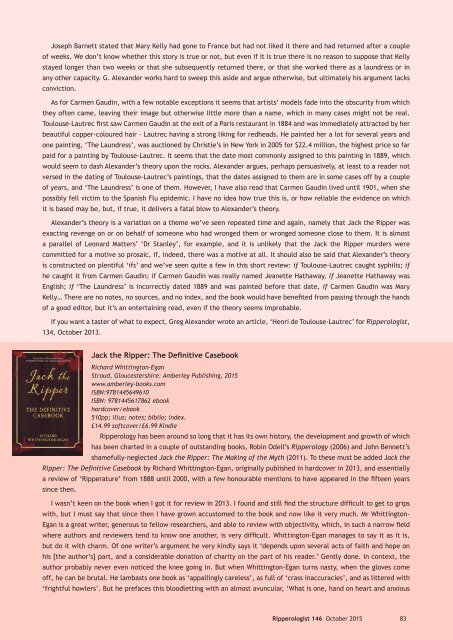GEORGE HUTCHINSON
orxwju5
orxwju5
You also want an ePaper? Increase the reach of your titles
YUMPU automatically turns print PDFs into web optimized ePapers that Google loves.
Joseph Barnett stated that Mary Kelly had gone to France but had not liked it there and had returned after a couple<br />
of weeks. We don’t know whether this story is true or not, but even if it is true there is no reason to suppose that Kelly<br />
stayed longer than two weeks or that she subsequently returned there, or that she worked there as a laundress or in<br />
any other capacity. G. Alexander works hard to sweep this aside and argue otherwise, but ultimately his argument lacks<br />
conviction.<br />
As for Carmen Gaudin, with a few notable exceptions it seems that artists’ models fade into the obscurity from which<br />
they often came, leaving their image but otherwise little more than a name, which in many cases might not be real.<br />
Toulouse-Lautrec first saw Carmen Gaudin at the exit of a Paris restaurant in 1884 and was immediately attracted by her<br />
beautiful copper-coloured hair - Lautrec having a strong liking for redheads. He painted her a lot for several years and<br />
one painting, ‘The Laundress’, was auctioned by Christie’s in New York in 2005 for $22.4 million, the highest price so far<br />
paid for a painting by Toulouse-Lautrec. It seems that the date most commonly assigned to this painting in 1889, which<br />
would seem to dash Alexander’s theory upon the rocks. Alexander argues, perhaps persuasively, at least to a reader not<br />
versed in the dating of Toulouse-Lautrec’s paintings, that the dates assigned to them are in some cases off by a couple<br />
of years, and ‘The Laundress’ is one of them. However, I have also read that Carmen Gaudin lived until 1901, when she<br />
possibly fell victim to the Spanish Flu epidemic. I have no idea how true this is, or how reliable the evidence on which<br />
it is based may be, but, if true, it delivers a fatal blow to Alexander’s theory.<br />
Alexander’s theory is a variation on a theme we’ve seen repeated time and again, namely that Jack the Ripper was<br />
exacting revenge on or on behalf of someone who had wronged them or wronged someone close to them. It is almost<br />
a parallel of Leonard Matters’ ‘Dr Stanley’, for example, and it is unlikely that the Jack the Ripper murders were<br />
committed for a motive so prosaic, if, indeed, there was a motive at all. It should also be said that Alexander’s theory<br />
is constructed on plentiful ‘ifs’ and we’ve seen quite a few in this short review: if Toulouse-Lautrec caught syphilis; if<br />
he caught it from Carmen Gaudin; if Carmen Gaudin was really named Jeanette Hathaway, if Jeanette Hathaway was<br />
English; if ‘The Laundress’ is incorrectly dated 1889 and was painted before that date, if Carmen Gaudin was Mary<br />
Kelly… There are no notes, no sources, and no index, and the book would have benefited from passing through the hands<br />
of a good editor, but it’s an entertaining read, even if the theory seems improbable.<br />
If you want a taster of what to expect, Greg Alexander wrote an article, ‘Henri de Toulouse-Lautrec’ for Ripperologist,<br />
134, October 2013.<br />
Jack the Ripper: The Definitive Casebook<br />
Richard Whittington-Egan<br />
Stroud, Gloucestershire: Amberley Publishing, 2015<br />
www.amberley-books.com<br />
ISBN:9781445649610<br />
ISBN: 9781445617862 ebook<br />
hardcover/ebook<br />
510pp; illus; notes; biblio; index.<br />
£14.99 softcover/£6.99 Kindle<br />
Ripperology has been around so long that it has its own history, the development and growth of which<br />
has been charted in a couple of outstanding books, Robin Odell’s Ripperology (2006) and John Bennett’s<br />
shamefully-neglected Jack the Ripper: The Making of the Myth (2011). To these must be added Jack the<br />
Ripper: The Definitive Casebook by Richard Whittington-Egan, originally published in hardcover in 2013, and essentially<br />
a review of ‘Ripperature’ from 1888 until 2000, with a few honourable mentions to have appeared in the fifteen years<br />
since then.<br />
I wasn’t keen on the book when I got it for review in 2013. I found and still find the structure difficult to get to grips<br />
with, but I must say that since then I have grown accustomed to the book and now like it very much. Mr Whittington-<br />
Egan is a great writer, generous to fellow researchers, and able to review with objectivity, which, in such a narrow field<br />
where authors and reviewers tend to know one another, is very difficult. Whittington-Egan manages to say it as it is,<br />
but do it with charm. Of one writer’s argument he very kindly says it ‘depends upon several acts of faith and hope on<br />
his [the author’s] part, and a considerable donation of charity on the part of his reader.’ Gently done. In context, the<br />
author probably never even noticed the knee going in. But when Whittington-Egan turns nasty, when the gloves come<br />
off, he can be brutal. He lambasts one book as ‘appallingly careless’, as full of ‘crass inaccuracies’, and as littered with<br />
‘frightful howlers’. But he prefaces this bloodletting with an almost avuncular, ‘What is one, hand on heart and anxious<br />
Ripperologist 146 October 2015 83




